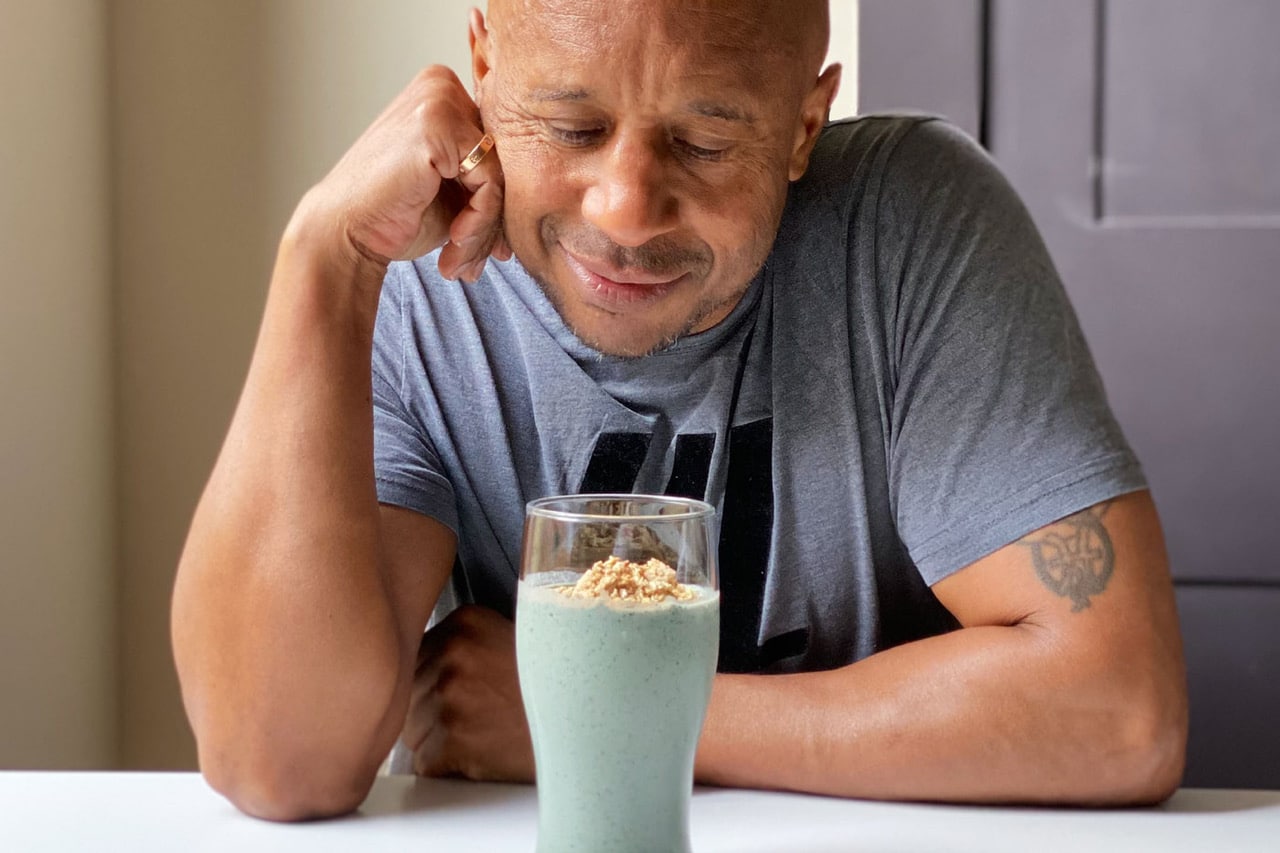FOR THE LAST four years, my daily ritual has been a 16/8 fasting diet. I have my smoothie with berries, avocado, banana, protein powder, and flax seeds at noon.
I blend it all with oat milk and kefir. And later in the evening, I would have my main meal where anything goes, because I find cooking boring for one.
Homemade or Shop-bought?
Smoothies are good for you, but not all are equal! Pre-made smoothies are high in hidden sugars and processed ingredients such as fruit purées and juices.
These purées concentrate sugars whilst removing the nutritional benefits of the whole natural fruit such as fibre, phytonutrients, vitamins and minerals. As with almost all foods, homemade versions using fresh or frozen ingredients will provide more nutritional value.
Give the body food it was designed to eat by nature – fruit.
The Benefits of Fruit
A review published in Food & Nutrition Research showed that fibre and fruit intake could protect against increasing waist circumference over time, partly because fruit is filling and stops you from overeating.
As well as feeling full for longer, fruit is associated with slower stomach emptying because of its high fibre and water content, which means that the consequent rise in blood sugar and insulin is less dramatic.
It prevents constipation and supports the growth of good bacteria in your digestive tract. In turn, that helps reduce inflammation, promote healthy immune function and maintain good mental health. Adequate fibre intake reduces the risks of heart disease and type two diabetes.
My Essential Ingredients
A handful of berries always goes in my smoothie; they are among the healthiest foods you can eat, and they can improve blood sugar and insulin response. They are also a great source of antioxidants known to protect your cells and reduce the risk of disease.
A study in healthy men discovered that consuming a single, 300-gram portion of blueberries helped protect their DNA against free-radical damage. In a six-week study, obese people with insulin resistance who drank a blueberry smoothie twice daily experienced more significant improvements in insulin sensitivity than those who consumed berry-free smoothies.
A ripe medium-sized banana (about 105 calories) provides excellent nutrition (rich in fibre, antioxidants and several nutrients) before, during and after endurance exercise. It is the perfect food for athletes due to its mineral content and easily digested carbs.
Half an Avocado in a smoothie can provide the ideal amount of mono-unsaturated fatty acids. It is a source of vitamins C, E, K and B6, riboflavin, niacin, folate, pantothenic acid, magnesium and potassium.
Avocados also provide lutein, beta carotene and omega-3 fatty acids. It contains high levels of healthy, beneficial fats that slow the breakdown of carbohydrates, which helps keep blood sugar levels stable.
Fat is essential for every component of the body. Eating healthy fats supports skin health, enhances fat-soluble vitamins, minerals and other nutrients, and even helps the immune system.
What A nutritionist thinks
I asked nutritionist, Charles Coaker, to break down the nutritional value of my smoothie and what he thought, and if there was anything in there that he felt could be improved upon or eliminated:
•••••••••••••••••••••••
Thanks Wayne. One of the first things I look for when assessing meals or smoothies is the possible blood sugar response. This smoothie contains more fat and protein (38.6g and 44.3g respectively) than a typical smoothie and contains a good portion of fibre (24g) which will significantly help balance the blood sugar response, which can be high in many smoothies.
Fat is not to be feared but the types of fat do matter. One ratio I always analyse is the omega-6 to omega-3 ratio. Omega-3s are anti-inflammatory whilst omega-6s are inflammatory.
This smoothie has a 2.5:1 ratio which is within the 1:1 – 3:1 ratio I love to see. Many people today have ratios that exceed 25-50:1. A high ratio such as this can help perpetuate chronic low-grade inflammation and promotes supra-physiological inflammatory responses.
Chronic inflammation is known as the “silent killer” and is widespread in industrialised nations due to our high intake of processed foods which contain high levels of omega-6s which are found heavily in seed oils.
A key benefit of smoothies is the convenience of increasing fruit and vegetable intake which can help you reach your micronutrient targets. This smoothie goes a long way in hitting a lot of your micronutrients in just one sitting. The recommended nutrient intake (RNI) is exceeded in the following micronutrients: B2, B12, Vitamin A, Vitamin K and Iron.
>90% of the RNI is also met in the following: B5, B6, Vitamin C, Calcium and Phosphorus.
The only nutrients which are low (<30% of the RNI) are: Selenium, Sodium and Zinc.
I’m pleased to see the use of kefir in this smoothie. Fermented foods are rich in healthy probiotic bacteria and I much prefer seeing them incorporated into a diet instead of buying probiotics which can be expensive and less beneficial to your microbiota.
Your microbiota consists of the vast number of bacteria, viruses, fungi and other microorganisms found in your digestive tract, and in particular your colon.
A healthy microbiota has many functions including regulating your immune system, digesting your food, and producing vitamins such as B12 and vitamin K amongst others. It is a growing field of research with more studies linking it to most disease states.
Add 1 brazil nut per smoothie. This is the best source for plant-based selenium and will allow you to reach your target for selenium intake. This will help ensure healthy thyroid and immune function.
I would recommend having sufficient animal protein outside in your other meals to help hit your protein goals and as a result you’ll hit your zinc targets.
•••••••••••••••••••••••
The Smoothie Take-away
A good smoothie takes longer to digest and thus slows down the release of energy from the rest of the ingredients. In the process, you increase the absorption of all the nutrients, levelling out your blood sugar levels and preventing the need for any ‘quick fix’ fast-food energy boosts that die away quickly, so you keep hunger pangs at bay for longer.
Final Word: The discipline to do my Intermittent Fasting makes it much easier to eat less often and avoid feeling hungry outside the eight-hour eating phase. You can be confident that when you eat, you are taking on board the entire range of nutrients a body requires to maintain optimum health.





